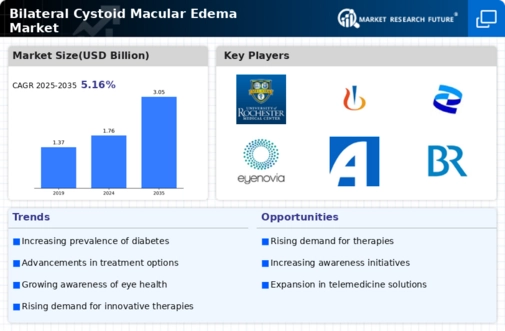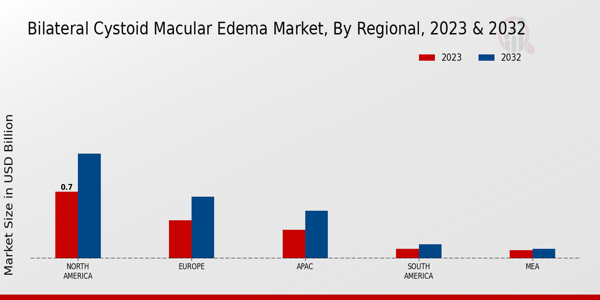Aging Population
The aging population is a significant driver of the Global Bilateral Cystoid Macular Edema Market Industry. As individuals age, the risk of developing eye disorders, including cystoid macular edema, increases. According to demographic studies, the global population aged 60 and above is projected to double by 2050, leading to a surge in age-related eye conditions. This demographic shift is expected to create a substantial demand for effective treatments and management strategies, thereby driving market growth. The anticipated compound annual growth rate of 5.12% from 2025 to 2035 underscores the potential for expansion in this sector.
Market Growth Projections
The Global Bilateral Cystoid Macular Edema Market Industry is projected to experience substantial growth over the next decade. With a market value of 1.76 USD Billion in 2024, it is expected to reach 3.05 USD Billion by 2035. This growth trajectory reflects a compound annual growth rate of 5.12% from 2025 to 2035, indicating a robust demand for innovative treatment options and increased healthcare investments. The market dynamics are influenced by various factors, including advancements in technology, rising prevalence of eye disorders, and enhanced healthcare expenditure, all contributing to the overall expansion of the industry.
Growing Awareness and Education
The growing awareness and education regarding eye health are pivotal in shaping the Global Bilateral Cystoid Macular Edema Market Industry. Initiatives aimed at educating the public about the risks and symptoms of eye disorders are leading to earlier diagnosis and treatment. Campaigns by health organizations and non-profits are instrumental in disseminating information, thereby encouraging individuals to seek medical attention promptly. This heightened awareness is likely to result in increased patient referrals and treatment uptake, contributing to the market's growth trajectory as more individuals are diagnosed and treated for cystoid macular edema.
Increased Healthcare Expenditure
Rising healthcare expenditure across various regions is a crucial factor propelling the Global Bilateral Cystoid Macular Edema Market Industry. Governments and private sectors are investing more in healthcare infrastructure, leading to improved access to eye care services. For instance, countries with higher healthcare budgets are witnessing enhanced screening and treatment programs for eye disorders, including cystoid macular edema. This trend is expected to foster market growth, as increased funding allows for the adoption of advanced technologies and therapies, ultimately benefiting patient care and driving the market's expansion.
Rising Prevalence of Eye Disorders
The increasing incidence of eye disorders globally is a primary driver for the Global Bilateral Cystoid Macular Edema Market Industry. Conditions such as diabetes and age-related macular degeneration contribute significantly to the rising cases of cystoid macular edema. For instance, the World Health Organization indicates that diabetic retinopathy affects approximately 1 in 3 individuals with diabetes, leading to a heightened demand for effective treatment options. This trend is expected to propel the market, with projections estimating the market value to reach 1.76 USD Billion in 2024, reflecting a growing need for innovative therapies.
Advancements in Treatment Modalities
Technological advancements in treatment modalities are significantly influencing the Global Bilateral Cystoid Macular Edema Market Industry. The development of novel pharmacological agents and surgical techniques enhances patient outcomes and expands treatment options. For example, the introduction of intravitreal injections has revolutionized the management of cystoid macular edema, providing targeted therapy with improved efficacy. As these innovations continue to emerge, they are likely to drive market growth, with an anticipated increase in market value to 3.05 USD Billion by 2035, indicating a robust demand for advanced treatment solutions.



















Leave a Comment